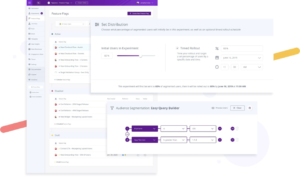Identify Ways to Improve Culture Amongst Your Team With Data Driven Results

Getting buy-in for experimentation isn’t always easy. Traditional testing methods are time-consuming, requiring input from multiple teams, cross-functional planning, and lead time to build tests. Implementing no-code tools into your technology stack helps you alleviate these issues.
Maximizing your resources is especially important for more technical experiments, which rely on your ability to hire and retain high-quality developers. No-code tools take the onus off these developers and provide a low-cost, high (ROI) way to increase team engagement with experimentation across the board.
They’re the first step toward building a culture of experimentation and testing throughout your organization. No-code tools do that by increasing visibility into essential aspects of the product development process and providing every team member with functionality to build these tests on their own. Autonomy makes your team feel more invested in creating tests and refining the product experience, and it frees up time to allocate to building the best possible products for customers.
No-Code Tools Democratize the Experimentation Process
With no-code tools, the power of experimentation is in everyone’s hands. It doesn’t matter whether you want to make changes to the CTA on a product landing page or the sequence of a mobile onboarding flow; the team that owns each process can easily make changes directly. When everyone gets involved with experiments in this way, it creates a better overall approach for the entire team.
Bringing more individuals into the experimentation process increases visibility into important customer experiences. That helps teams throughout your organization build empathy with the customer and their experience with your product. Not only will this boost engagement with product development throughout your organization, but it will also empower individuals to contribute their own unique thoughts and ideas on what needs to be improved.
And the ideas they present will come from a place of in-depth customer understanding too. This insight diversifies your pool of ideas and helps teams build more engaging and valuable products for your customers.

Let’s say you’re building a platform to help freelancers connect with potential clients in a specific market, and one of your marketing team members spent some time as a freelancer. Their experiences with client management provide a lot of insight into what features really matter for that target audience.
When everyone is involved with experiments, each team member will feel invested in the success of the product because they have a fundamental understanding of the customer experience and a shared sense of ownership over it. This investment empowers teams that would otherwise run tests on their own to start experimenting with their customer interactions.
As your customer’s wants and needs change and the product evolves, this investment will keep each member of the team on the same path toward shared goals. It will keep them connected to the value your product provides and the overall impact on the customers daily lives.
No-Code Tools Help You Allocate Resources Where They Matter Most
When every member of your team can actively experiment with products and features on their own, it frees up valuable time and resources your development team can allocate to other projects. Whether it’s refocusing on an update to a buggy feature that’s plagued customers for months or thinking of new ways to improve the product with structural upgrades, you’ll have the time and capacity to do it.
Combine this with the additional perspectives you gain by democratizing the experimentation process, and it’s easy to see how no-code tools help your team allot their time to what really matters most—your product.
Decreasing the amount of work required to build these tests means developers can focus on executing through the product development life cycle more efficiently. It provides them with more time to create new and exciting features for your customers. And many no-code tools help you maintain a consistent release schedule, streamlining the process of defining your target audience, building out test variants, and pushing features live.

Your product and marketing teams will be able to build out their own unique processes for experimentation. This freedom helps teams tailor the testing experience to their needs and learn together as a group. And by testing together as a team, everyone involved will see the impact these tests have on real customers as they analyze results.
The inherent learning opportunities tied to this analysis are another positive aspect of no-code platforms, which often include a robust analytics suite of easy-to-digest data for specific use cases throughout your team. Fast access to data keeps every member of the team focused on performance as well as solutions, which makes their insight into the customer experience that much more valuable.
When you free up developer resources, it also helps you reduce operational costs at the individual level. Your development team will be able to focus their time on the specific tasks required to take a project from idea all the way through to completion, which will help you maximize your overall spend and recoup more revenue from new products and features as a result.
No-Code Tools Make It Easy to Scale Important Processes Faster
When you implement no-code tools into your technology stack, it helps streamline critical processes throughout your organization. You’ll be able to allocate resources effectively, cut down on potential bottlenecks, and proactively address any issues before they cause frustration for your team. Removing these blockers fosters a culture of experimentation and makes it easier for everyone to get involved with upcoming initiatives that push the company forward.
And these improvements won’t just impact processes related to product development; you’ll also see efficiency gains across workflows in ideation, planning, active development, and beyond:
- Product owners will have more time to devote to prioritization and strategy.
- Developers will have more time to focus on complex tasks.
- Marketing will have more time to devote to messaging and positioning campaigns.
- Sales and support will have more time to craft targeted solutions for customers.
Every member of your team will experience the impact of implementing these tools. They’ll have the autonomy to workshop ideas and define the specific workflows that work best for their team members and the cross-functional teams they collaborate with on a day-to-day basis.
No-code tools also make it easier to scale data security and privacy than a custom-built solution. Instead of spending their time checking and double-checking their work to ensure compliance, your team can trust these third-party tools to keep important data safe. And the same goes for your customers: No-code tools make it easy to ensure data privacy and security throughout their experience with your product.
This added layer of oversight is especially important for smaller teams whose resources and bandwidth are frequently at risk. It’s easy to lose track of every piece of code when you’re a solo developer, for example, or trying to wrangle a team that’s growing faster than your infrastructure can handle. No-code tools ensure that every member of the team can execute on their work with confidence.
When Everyone Experiments, It Helps Teams Mature
Teaching your team how to build experiments together using no-code tools is one most effective ways to create a culture of experimentation throughout your organization. It helps everyone feel invested in their work and the value it provides to customers while also highlighting the importance of active collaboration to achieve business and project goals. Your team can use this experience to refine processes and continually add value to their relationships with one another.
